Crazy Charlie flies are your secret weapon for bonefishing success, and flyermedia.net is here to guide you. This versatile pattern, designed to avoid snags, can be customized to match any environment and attract those elusive bonefish. Discover the art of fly tying and unlock a world of angling possibilities. With the right techniques and materials, you’ll be crafting effective Crazy Charlie flies in no time. Learn more about bonefish flies, saltwater fly fishing, and fly tying techniques at flyermedia.net.
1. What is a Crazy Charlie Fly and Why is it Effective?
A Crazy Charlie fly is a popular and effective bonefish fly pattern known for its simplicity, versatility, and ability to attract bonefish in various saltwater environments. The effectiveness lies in its ability to mimic small crustaceans and other prey that bonefish feed on, its design to prevent snagging on the bottom, and the enticing movement it creates in the water.
- Mimicry: The fly imitates the appearance and movement of small shrimp, crabs, and other invertebrates that bonefish commonly prey upon, making it an appealing target.
- Inverted Hook Design: The bead chain eyes tied on top of the hook shank cause the fly to ride inverted, reducing the chances of snagging on the bottom in shallow, grassy flats where bonefish are often found.
- Movement: The materials used, such as Krystal Flash and calf tail, provide enticing movement and shimmer in the water, attracting the attention of bonefish and triggering strikes.
- Versatility: Crazy Charlie flies can be tied in various colors and sizes to match the specific conditions and prey available in different bonefishing locations. Popular color variations include tan, white, pink, chartreuse, and brown.
- Proven Success: The Crazy Charlie has a long history of success in bonefishing around the world, making it a trusted and reliable choice for anglers targeting these elusive fish.
- Simplicity: The Crazy Charlie is relatively easy to tie, making it a great option for beginner fly tiers who want to create effective bonefish flies.
2. What Materials Do I Need to Tie a Crazy Charlie Fly?
To tie a Crazy Charlie fly, gather these essential materials.
| Material | Purpose |
|---|---|
| Hook | Provides the foundation for the fly and secures it to the fishing line. |
| Thread | Secures the materials to the hook and creates the fly’s body. |
| Eyes | Adds weight to the fly and causes it to ride inverted, preventing snags. |
| Overbody | Creates a realistic translucent shell-like appearance on the fly’s back. |
| Underbody | Adds shimmer and bulk to the fly’s body, attracting bonefish. |
| Wing Flash | Adds additional flash and movement to the fly, further enticing bonefish. |
| Wing | Provides a silhouette and adds to the fly’s overall profile in the water. |
Here’s a detailed breakdown:
- Hook: TMC 811S (#2-8) – A strong, saltwater-resistant hook ideal for bonefish flies.
- Thread: 3/0 or UNI 6/0 to match body color – Provides a secure base for tying materials.
- Eyes: Stainless steel or brass bead chain eyes, sized to hook – Adds weight and ensures the fly rides hook-point up. You can source these from fly tying suppliers like Charlie’s Fly Box.
- Overbody: Clear D-Rib, sized to hook – Creates a realistic, translucent carapace effect.
- Underbody: Krystal Flash – Adds shimmer and bulk.
- Wing Flash: Krystal Flash – For added attraction.
- Wing: Calf Tail – Provides profile and movement.
3. Step-by-Step Guide: How to Tie a Crazy Charlie Fly
Follow these steps to create your own effective Crazy Charlie fly:
3.1. Step 1: Prepare the Hook and Thread Base
Start by securing the hook in your vise. Begin the thread behind the hook eye and build a thread base on the front half of the shank.
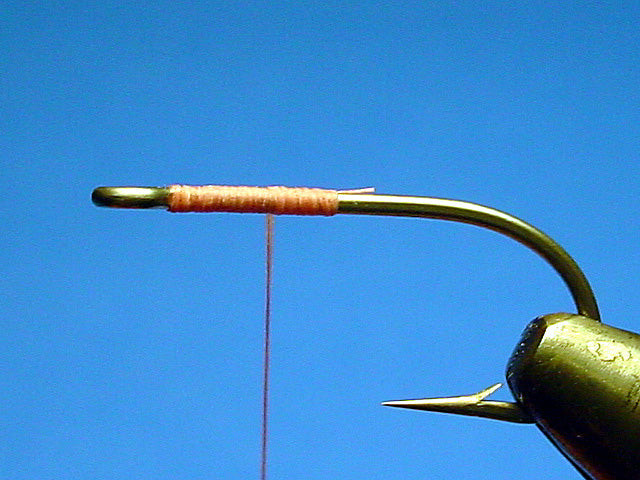 Thread base on the hook shank
Thread base on the hook shank
3.2. Step 2: Attach the Bead Chain Eyes
Figure eight a pair of bead chain eyes to the top of the shank, about two or three eye lengths back from the hook eye. This placement is crucial for the fly’s balance and snag-resistant properties.
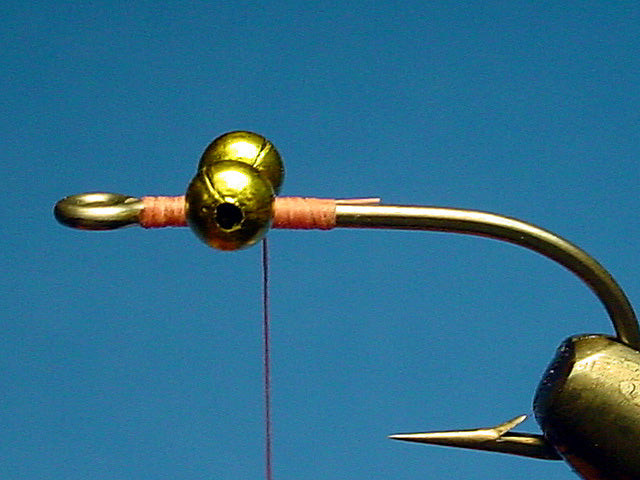 Bead chain eyes attached to the hook shank
Bead chain eyes attached to the hook shank
3.3. Step 3: Secure the Eyes and Build a Thread Base
Straighten the eyes so they are level on the shank. Build a thread base back to the bend of the hook to provide a solid foundation for the rest of the materials.
 Bead chain eyes attached to the hook shank
Bead chain eyes attached to the hook shank
3.4. Step 4: Tie in the V-Rib
Return the thread to the back of the eyes and tie in a six-inch long piece of V-Rib (or D-Rib) with the flat side up. This will form the overbody of the fly.
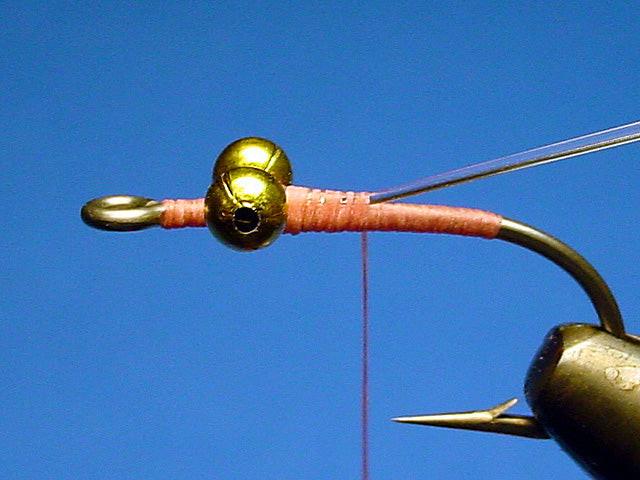 V-Rib tied in at the back of the eyes
V-Rib tied in at the back of the eyes
3.5. Step 5: Secure the V-Rib Along the Shank
Continue wrapping the thread back over the V-Rib to the bend of the hook, securing it in place. This creates a smooth underbody for the fly.
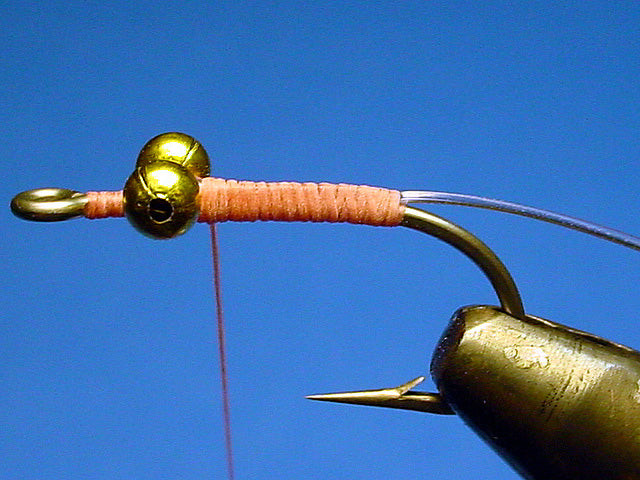 Thread wrapped over the V-Rib to the hook bend
Thread wrapped over the V-Rib to the hook bend
3.6. Step 6: Add the Krystal Flash
Return the thread to the eyes and tie in six strands of Krystal Flash. These strands will add shimmer and attraction to the fly.
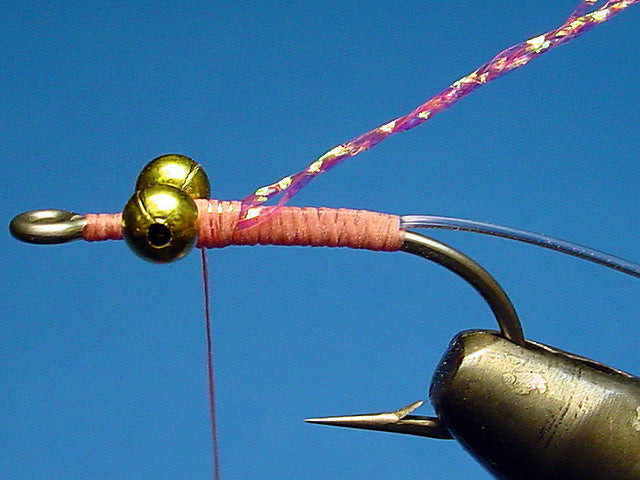 Krystal Flash tied in at the eyes
Krystal Flash tied in at the eyes
3.7. Step 7: Wrap the Krystal Flash to the Bend
Wrap the Krystal Flash all the way to the bend of the hook, creating a shimmering underbody.
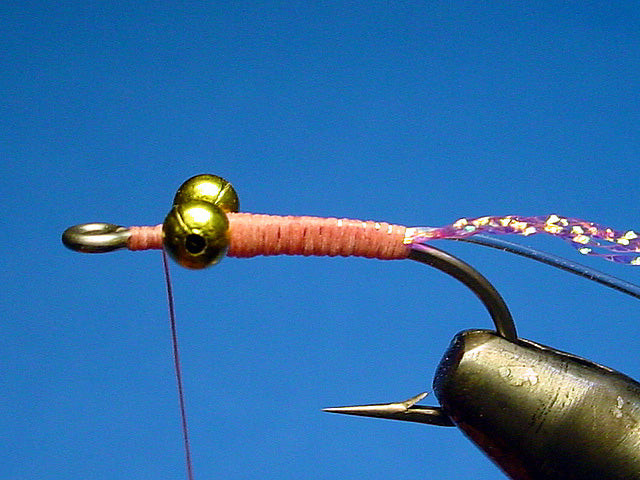 Krystal Flash wrapped to the hook bend
Krystal Flash wrapped to the hook bend
3.8. Step 8: Return the Krystal Flash to the Front
Return the thread to the front of the eyes and start wrapping the Krystal Flash forward to the eyes, building up the body of the fly.
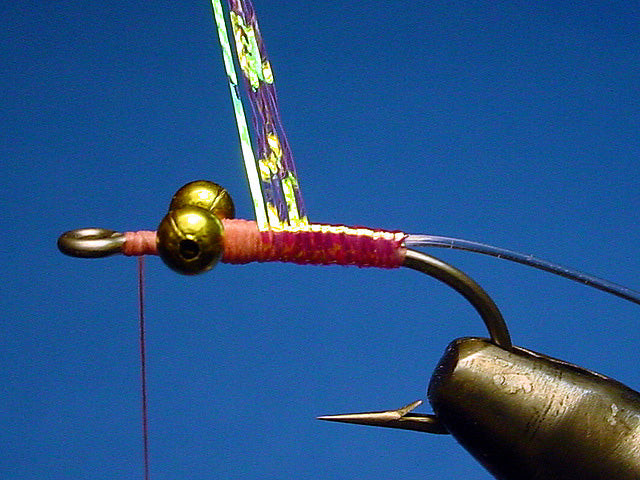 Krystal Flash wrapped back to the eyes
Krystal Flash wrapped back to the eyes
3.9. Step 9: Secure the Krystal Flash Around the Eyes
Wrap the Krystal Flash in a figure eight around the eyes and tie it off in front of them, securing the underbody.
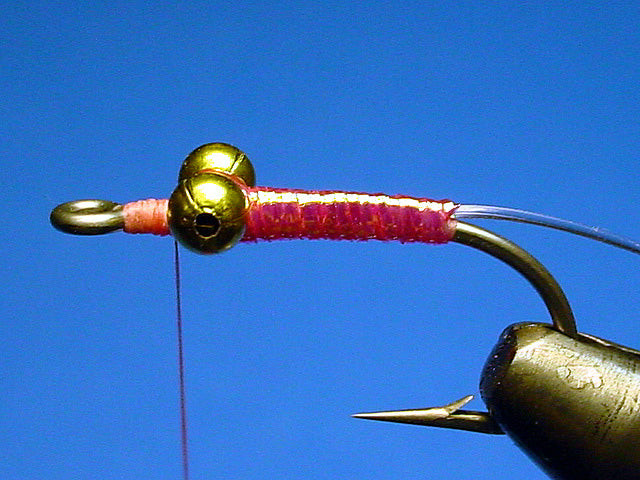 Krystal Flash secured around the eyes
Krystal Flash secured around the eyes
3.10. Step 10: Wrap the V-Rib Forward
Wrap the V-Rib forward with the round side up over the Krystal Flash underbody, up to the eyes, and figure eight it through the eyes as well. This creates a smooth, segmented overbody.
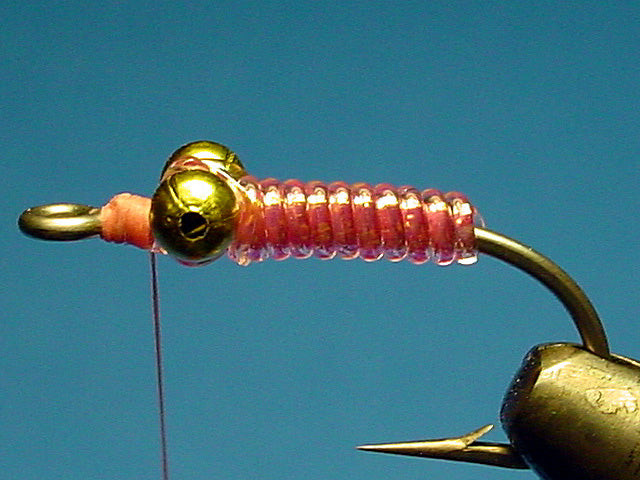 V-Rib wrapped forward and secured around the eyes
V-Rib wrapped forward and secured around the eyes
3.11. Step 11: Invert the Hook
Invert the hook in the vise to prepare for adding the wing.
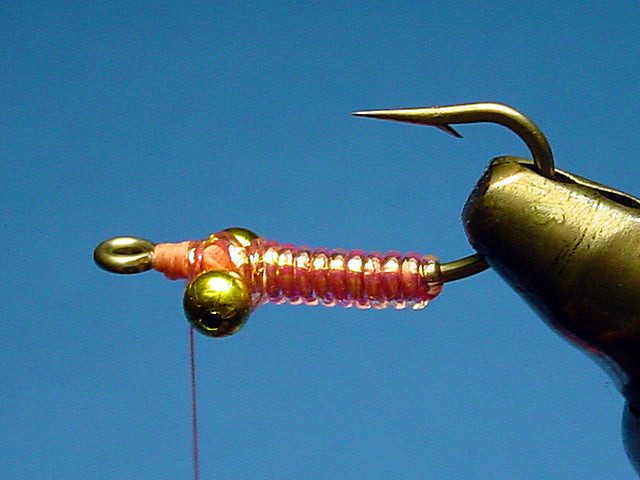 Hook inverted in the vise
Hook inverted in the vise
3.12. Step 12: Tie in Wing Flash
Tie in two strands of Krystal Flash at the rear edge of the hook eye and double them over. These will form the wing flash.
 Wing Flash tied in at the rear of the hook eye
Wing Flash tied in at the rear of the hook eye
3.13. Step 13: Secure the Wing Flash
Wrap over the Krystal Flash so it lies back over the body, securing the wing flash in place.
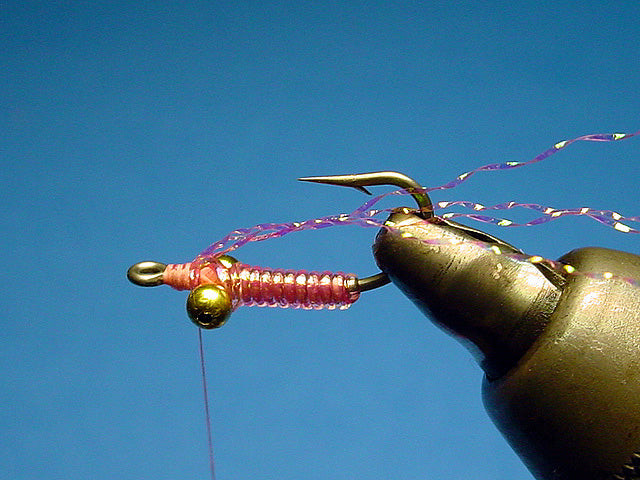 Wing Flash secured over the body
Wing Flash secured over the body
3.14. Step 14: Prepare the Calf Tail Wing
Cut and clean a clump of calf tail hair. Do NOT stack it. Measure the tips to just past the bend of the hook.
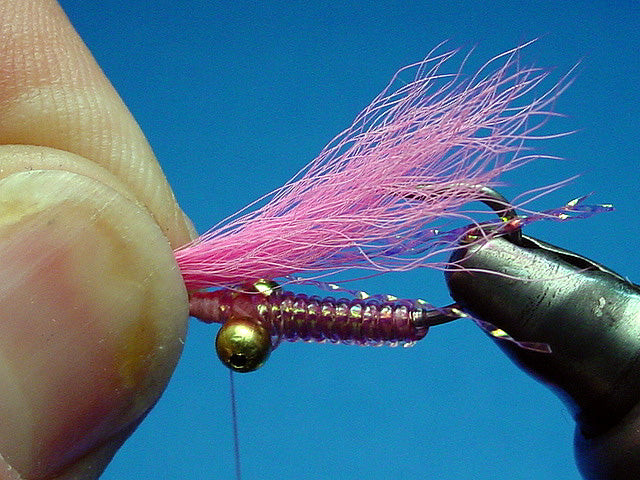 Calf tail measured for the wing
Calf tail measured for the wing
3.15. Step 15: Tie in the Calf Tail Wing
Tie in the calf tail behind the eye with several tight turns of thread. Ensure the wing is securely attached.
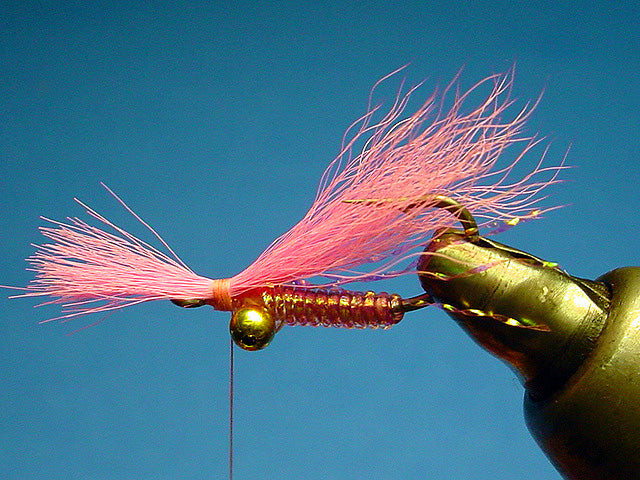 Calf tail tied in behind the eye
Calf tail tied in behind the eye
3.16. Step 16: Finish the Head
Clip the butt ends of the calf tail as close to the shank as possible. Wrap a smooth thread head over the stubs, creating a neat finish.
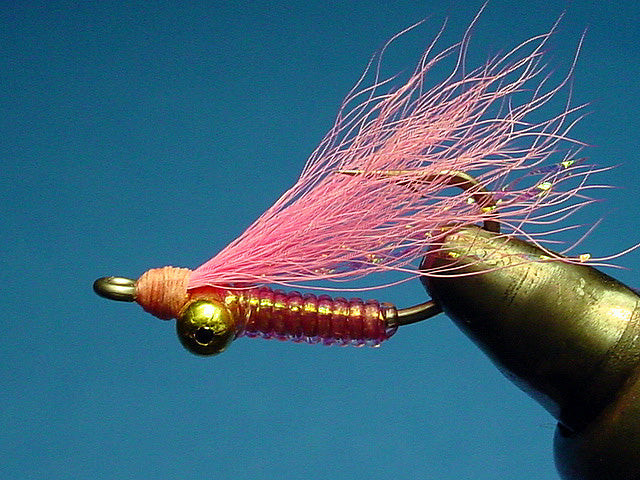 Thread head wrapped over the stub ends
Thread head wrapped over the stub ends
3.17. Step 17: Cement the Head
Apply a coat of head cement to the thread head. After the cement has dried, apply another coat of Sally Hansen’s Hard As Nails to seal the head and provide durability.
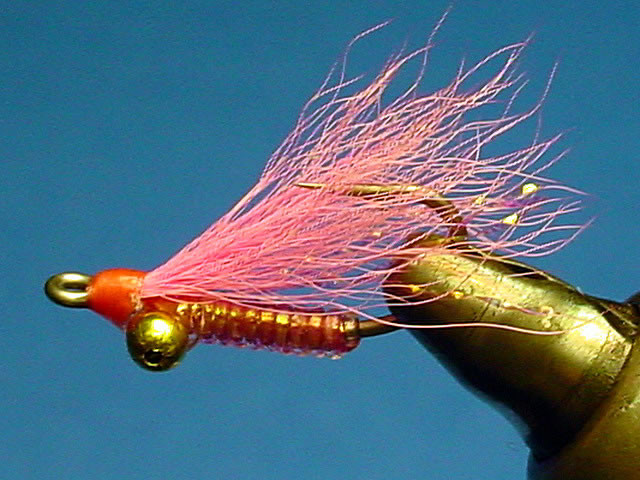 Head cement applied to the thread head
Head cement applied to the thread head
4. What Are the Best Color Combinations for Crazy Charlie Flies?
The best color combinations for Crazy Charlie flies often depend on the specific conditions and prey found in the fishing location. Some popular and effective color combinations include:
- Tan/White: A classic combination that imitates many small crustaceans and works well in clear water conditions.
- Pink/White: Effective in murky or stained water and can resemble shrimp or small baitfish.
- Chartreuse/White: A highly visible combination that can attract bonefish in a variety of conditions.
- Brown/Tan: Mimics crabs and other bottom-dwelling creatures, making it a good choice for fishing near muddy or sandy bottoms.
- Olive/White: Can imitate small baitfish or shrimp and works well in grassy or weedy areas.
Experimenting with different color combinations and observing the local prey species can help you determine the most effective colors for your Crazy Charlie flies.
5. What Size Crazy Charlie Fly Should I Use?
The size of the Crazy Charlie fly you should use depends on several factors, including the size of the bonefish in the area, the water clarity, and the size of the natural prey. Generally, Crazy Charlie flies in sizes #2 to #8 are commonly used for bonefishing.
- Larger Flies (#2-#4): Use these in murky water or when targeting larger bonefish. They provide a bigger profile and are easier for the fish to see.
- Smaller Flies (#6-#8): Use these in clear water or when bonefish are particularly wary. They offer a more subtle presentation and are less likely to spook the fish.
It’s always a good idea to carry a variety of sizes to adapt to changing conditions and bonefish behavior. Observing the size of the natural prey in the area can also help you determine the appropriate fly size to use.
6. What Gear Do I Need to Fish with a Crazy Charlie Fly?
To effectively fish with a Crazy Charlie fly, you’ll need the following gear:
- Fly Rod: A 9-foot, 7- or 8-weight fly rod is ideal for bonefishing.
- Fly Reel: A saltwater-safe fly reel with a smooth drag system is essential for fighting bonefish.
- Fly Line: A weight-forward floating fly line designed for saltwater use is recommended.
- Leader: A 9- to 12-foot tapered leader with a tippet strength of 8-12 lbs.
- Tippet: Fluorocarbon tippet material in 8-12 lb test for abrasion resistance and low visibility.
- Wading Boots: Protect your feet while wading on flats.
- Polarized Sunglasses: Essential for spotting bonefish in shallow water.
- Fly Box: To store and organize your Crazy Charlie flies and other bonefish patterns.
- Line Clippers: For cutting tippet and leader material.
- Pliers: For removing hooks from fish.
7. What Are the Best Techniques for Fishing a Crazy Charlie Fly?
Effective techniques for fishing a Crazy Charlie fly involve presentation, retrieve, and strike detection. Here’s a breakdown:
- Presentation:
- Stealth: Approach the fishing area quietly and avoid making sudden movements that could spook the bonefish.
- Casting: Make accurate casts to place the fly in front of the bonefish, allowing it to sink to the bottom.
- Leading the Fish: Cast the fly several feet ahead of the fish’s direction of travel to intercept its path.
- Retrieve:
- Slow, Jerky Motion: Use a slow, jerky retrieve to imitate the movement of a small crustacean.
- Vary the Retrieve: Experiment with different retrieve speeds and patterns to see what triggers a strike.
- Bottom Contact: Allow the fly to bounce along the bottom occasionally to mimic natural prey.
- Strike Detection:
- Watch the Line: Pay close attention to the fly line for any sudden movements or twitches that indicate a strike.
- Feel the Strike: Be prepared to feel a subtle tug or bump on the line when a bonefish takes the fly.
- Quick Hookset: Set the hook immediately with a sharp upward lift of the rod tip to secure the hook in the fish’s mouth.
8. Where Can I Find Bonefish to Fish with a Crazy Charlie?
Bonefish are primarily found in shallow, tropical and subtropical saltwater environments, often near flats, mangroves, and coral reefs. Some of the best places to find bonefish include:
- Bahamas: Known for its vast flats and abundant bonefish populations.
- Florida Keys: Offers excellent bonefishing opportunities in its shallow flats and channels.
- Belize: Features pristine flats and diverse marine ecosystems that support healthy bonefish stocks.
- Mexico (Yucatan Peninsula): Provides access to expansive flats and mangrove-lined lagoons teeming with bonefish.
- Christmas Island: A remote atoll in the Pacific Ocean renowned for its world-class bonefishing.
Consulting with local guides and fly shops can provide valuable insights into the best locations and times to fish for bonefish in these areas.
9. What is the History of the Crazy Charlie Fly?
The Crazy Charlie fly was developed by Bob Nauheim, a fly fishing guide in Andros Island, Bahamas, in the late 1970s. Nauheim created the fly to address the challenges of fishing for bonefish in the shallow, grassy flats of the Bahamas. The original design featured bead chain eyes tied on top of the hook shank, which caused the fly to ride inverted and reduce the chances of snagging on the bottom. The fly quickly gained popularity among bonefish anglers due to its effectiveness and versatility. Over the years, the Crazy Charlie has become one of the most widely used and successful bonefish flies in the world, with anglers adapting the pattern to suit various conditions and locations.
10. How Can I Improve My Bonefishing Success with Crazy Charlie Flies?
Improving your bonefishing success with Crazy Charlie flies involves several key strategies:
- Practice Your Casting: Accurate and stealthy casts are essential for presenting the fly effectively.
- Study Bonefish Behavior: Understanding bonefish feeding habits and movement patterns can help you target them more effectively.
- Match the Hatch: Observe the natural prey in the area and select Crazy Charlie flies that match their size, color, and profile.
- Use High-Quality Materials: Tying your own Crazy Charlie flies with durable and realistic materials can improve their performance and longevity.
- Fish with Experienced Guides: Hiring a local guide can provide valuable insights into the best fishing locations, techniques, and fly patterns.
- Pay Attention to Detail: Rig your gear carefully, use sharp hooks, and check your knots regularly to avoid losing fish.
- Be Patient and Persistent: Bonefishing can be challenging, so it’s important to remain patient and persistent, even when the fish are not biting.
Remember to always practice ethical angling and conservation practices to protect bonefish populations and their habitats.
Flyermedia.net is your premier destination for all things aviation and now, angling! Whether you’re a seasoned pilot or a passionate angler, we’ve got you covered.
Frequently Asked Questions (FAQ) About Tying and Using Crazy Charlie Flies
1. What is the main purpose of the bead chain eyes on a Crazy Charlie fly?
The bead chain eyes serve two main purposes: to add weight to the fly, helping it sink quickly, and to make the fly ride inverted (hook point up), which reduces the chances of snagging on the bottom.
2. Can I use different types of hooks for tying Crazy Charlie flies?
Yes, while the TMC 811S is a popular choice, you can use other saltwater-resistant hooks designed for bonefish flies. Just ensure the hook is strong and has a wide gap.
3. What is D-Rib and why is it used in the Crazy Charlie pattern?
D-Rib is a clear, flexible material used to create the overbody of the fly. It provides a realistic, translucent shell-like appearance and adds durability to the fly.
4. How important is the wing color of the Crazy Charlie fly?
The wing color can be important, as it provides a silhouette and adds to the fly’s overall profile in the water. Experiment with different colors to see what works best in your local fishing conditions.
5. What is the best way to store my Crazy Charlie flies?
Store your flies in a waterproof fly box with compartments to keep them organized and protected from damage.
6. Can I use Crazy Charlie flies for other saltwater species besides bonefish?
Yes, Crazy Charlie flies can also be effective for other saltwater species that feed on small crustaceans, such as permit, jacks, and snook.
7. How often should I change my Crazy Charlie fly when fishing?
Change your fly if it becomes damaged, frayed, or heavily slimed. It’s also a good idea to change flies periodically to try different colors and sizes.
8. What is the best knot to use for attaching a Crazy Charlie fly to my tippet?
The improved clinch knot or the non-slip loop knot are both excellent choices for attaching a Crazy Charlie fly to your tippet.
9. How do I prevent my Crazy Charlie fly from spinning in the water?
Ensure that the materials are evenly distributed around the hook shank and that the fly is properly balanced. A slight bend in the hook shank can also help prevent spinning.
10. Where can I find more information about bonefishing techniques and fly patterns?
You can find more information about bonefishing techniques, fly patterns, and fishing locations on flyermedia.net, as well as in books, magazines, and online forums dedicated to saltwater fly fishing.
Ready to take your Crazy Charlie fly tying and bonefishing skills to the next level? Visit flyermedia.net today to explore a wealth of resources, including in-depth articles, expert tips, and the latest aviation news. Whether you’re seeking to perfect your fly tying techniques, discover new bonefishing destinations, or stay informed about the aviation world, flyermedia.net is your ultimate destination. Contact us at 600 S Clyde Morris Blvd, Daytona Beach, FL 32114, United States, or call +1 (386) 226-6000. Your adventure awaits at flyermedia.net!